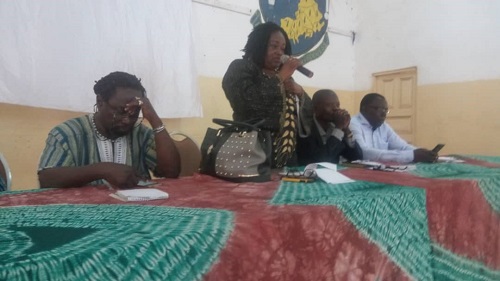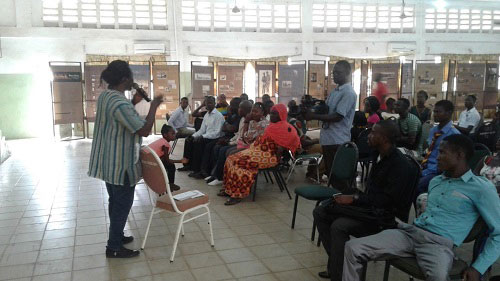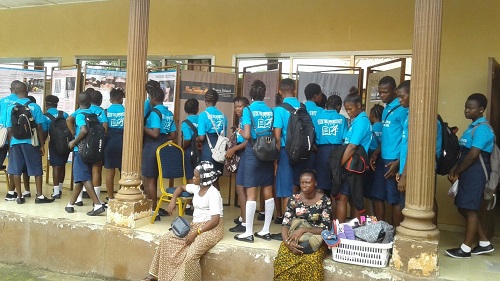Wilberforce Institute - University of Hull, Phase 1 of the Antislavery Knowledge Network
Posted on 31 July 2018 by Dr. Lennon Mhishi
As part of the Antislavery Knowledge Network, the Wilberforce Institute at the University of Hull has been working in partnership with several organisations in Sierra Leone at the pilot phase of the project, to establish foundations and explore the possibilities for further work on contemporary slavery in Sierra Leone.
One such partnership has been with the Monuments and Relics Commission (MRC) , the organization responsible for the protection of cultural heritage in Sierra Leone. The MRC are interested in raising awareness of contemporary slavery, as well as expanding on a project they have undertaken as part of the pilot, entitled Museum Travel Exhibition: A Platform for Dialogue with Communities on Contemporary Slavery in Sierra Leone.
Sierra Leone is entangled in the histories of the transatlantic slave trade, especially as a place where the formerly enslaved were settled. In addition to engaging with this complex past, the MRC recognises what they regard as a continuum, or the continuities of slavery in the present, as it relates to issues such as forced labour, forced marriage and human trafficking, for instance. With a recent history of conflict and developmental challenges that produce socio-economic and political conditions conducive to forms of exploitation, the challenges of contemporary slavery are timely and significant. The human development index (HDI) of Sierra Leone, which is the index used by the United Nations to measure the progress of a country, places Sierra Leone in 180th place in the table of 188 countries published. Although such indexes and rankings are contentious, this provides a guide to the scale of the developmental challenges faced by the country, and why the work by the MRC exploring contemporary slavery as a developmental issue is significant.
The National Museum in Sierra Leone recently opened a small exhibition on contemporary slavery, as part of its Freedom Week 2017. This exhibition was the first of its kind, although it deliberately made no explicit reference to the problem of slavery in Sierra Leone. The pilot proposal is to take out the exhibition to four districts in Sierra Leone (Bo, Kenema, Kono, Makeni), where it will be used to engage local communities with the question of contemporary slavery in their own dialects. The longer-term objective is to use this material as the basis of a new exhibition in Freetown on contemporary slavery in Sierra Leone.
Based on a report provided by the MRC, some insights into the work they have been doing as part of the pilot can be gleaned. In June of 2018, the MRC took the travelling exhibit to Bo, the capital and administrative centre of Bo district and the largest city in the Southern Province of the country. The Bo Modern Slavery Museum Travel Exhibit was held on the 13th and 14th June 2018. The official opening of the exhibit and dialogue with invited relevant stakeholders took place at the Bo District Council Hall on 13 June and the following day the exhibit opened to the entire public in Bo District, ranging from pupils, students, researchers, media practitioners, government, civil society, non-governmental organizations etc. to coordinate efforts to influence actions to minimize and further eradicate the various forms of contemporary forms of slavery prevalent in Sierra Leone.
The MRC sent invitations to stakeholders in Bo District for the dialogue on modern slavery and a media strategy was developed collaboratively with the Bo District Council to facilitate public awareness on the controversial subject of modern slavery.

Chairperson Monuments and Relics Commission making her maiden statement at the Official Opening of Museum Travel Exhibit at Bo District Council
Isatu Smith, chairperson of the MRC, acknowledged that the Modern Slavery Exhibit was curated by the British Council in Sierra Leone with the goal of raising awareness on the sensitive subject of Modern Slavery in the world, outlining the root causes, consequences and mitigating interventions. The other Exhibit on Bunce Island Slave Castle was curated by Joseph Opala and forms part of the temporary Exhibits at the National Museum.
Isatu Smith cited that both exhibits (Bunce Island Slave Castle and Modern Slavery) displayed in Bo put into context the historical and contemporary modes of enslavement and their consequences on sustainable development. “We are holding this modern slavery museum travel exhibit dialogue session just after June 12, a day set aside to advocate on child labor globally” she said. She also emphasized that the gathering of relevant stakeholders is inclined towards an action-oriented methodology that will inform change in attitude on modern slavery in Sierra Leone.

Commissioner Charlie Haffner facilitating dialogue sessions
The exhibits on the Trans-Atlantic Slave Trade and modern Slavery are normally housed at the National Museum in Freetown, but not all Sierra Leoneans visit the museum to interact with these exhibits. Therefore, the Monuments and Relics Commission travelling with the exhibits to Bo District provided an opportunity for those who do not traditionally visit museums to learn about these two forms of slavery thereby arousing interest in the wider public and further integrating learning and fostering opportunities for changing attitudes.
The Museum Travel Exhibit served as a backdrop for an open and frank discussion on the issue of contemporary slavery by relevant stakeholders. The exhibit is made up of educative multimedia panels that draw from an array of issues on modern slavery that foster community empowerment to counter the causes and effects of contemporary slavery and help marshal preventive mechanism. For instance, lack of income and desperation, lack of educational opportunities, unemployment etc. were highlighted by various speakers during the official ceremony.

SOS Herman Gmeinner International School pupils viewing the exhibit on the second day.
The work by the MRC is part of the first phase of the AKN project, which is expected to highlight some of possibilities and challenges of working in different country contexts and with different partners. This is expected to inform the second phase of the project, which is currently at the commissioning phase.